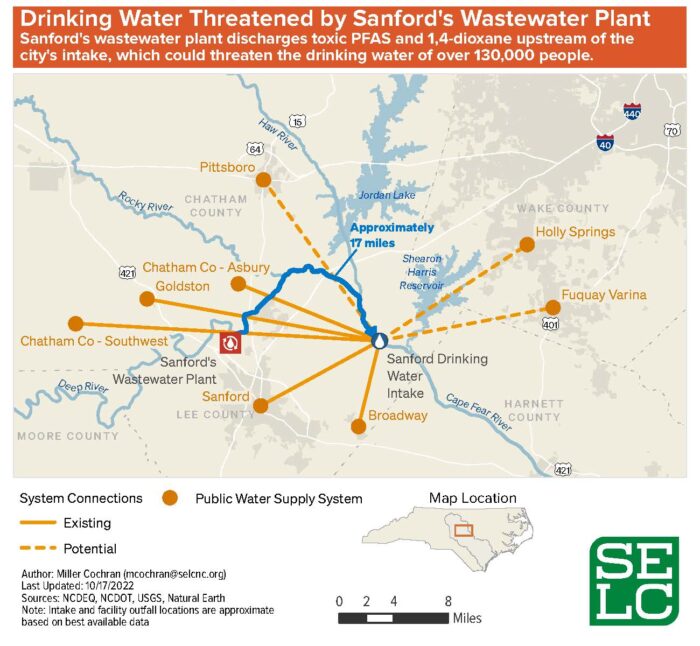Permit could perpetuate PFAS problems in the Cape Fear River Basin
Updated March 7, 2023:
Ahead of a March 7 public hearing and March 8 public comment deadline, the Southern Environmental Law Center warned that a state draft permit for a Sanford wastewater treatment plant allows discharge contaminated with PFAS—also known as forever chemicals—and toxic 1,4 dioxane upstream of the city’s own drinking water intake for 50,000 people. Conventional treatment does not remove these harmful pollutants from treated drinking water and Sanford plans to expand its drinking water services to more North Carolina communities, as SELC pointed out in comments it submitted to the N.C. Department of Environmental Quality.
“DEQ knows how to clean up the toxic pollution from Sanford’s wastewater treatment plant,” says Geoff Gisler, an SELC senior attorney and program director. “The agency cannot continue to look the other way as Sanford dumps forever chemicals and other harmful pollution into its own drinking water source, which it also plans to use to supply other North Carolina communities with drinking water.”
Read the story as originally reported below for more details.
A draft permit currently allows the City of Sanford to discharge wastewater contaminated with forever chemicals into downstream drinking water supplies in North Carolina’s Cape Fear River Basin, where the Southern Environmental Law Center has been working for years to stop this pollution at its source.
“The number of chemicals that we know are polluting our water and communities has grown dramatically in recent decades,” says Senior Attorney Geoff Gisler, leader of SELC’s Clean Water Program. “We can’t keep letting this happen and we won’t. We need polluter accountability now.”

The discharges in question are contaminated with toxic 1,4-dioxane and PFAS from the city’s wastewater treatment plant. Sanford discharges the contaminated wastewater into the Deep River approximately 17 miles upstream of the city’s own drinking water intake, which provides the drinking water for more than 50,000 people in Sanford, Goldston, Lee County, and parts of Chatham County.
Sanford also announced the intention to expand its drinking water services to provide drinking water to the cities of Pittsboro, Fuquay-Varina, and Holly Springs, which would then provide drinking water to more than 135,000 North Carolinians.
“From Pittsboro to communities further downstream, the Cape Fear River Basin and people who rely on it are already overburdened with toxic PFAS and 1,4-dioxane contamination,” says Gisler. “It’s clear that the best way to confront this pollution is stopping it at its source.”
SELC submitted comments to the North Carolina Department of Environmental Quality on behalf of Haw River Assembly and Cape Fear River Watch.
The agency has the authority and responsibility under existing law to prevent this pollution, as outlined in the comments and as demonstrated in SELC’s work to stop Chemours’ PFAS pollution of the Cape Fear River.
We will be monitoring the issue closely.
